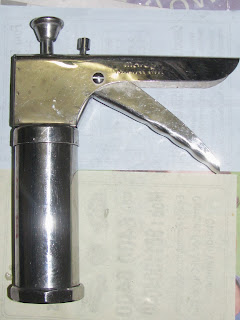First and foremost what is warhad? What I gather is this, that those Maharashtrians living in Vidharbha area of Maharashtra call themselves Warhadi manase. Warhad is a very dry part of land with low rainfall. So most of the food items that are made, last long due to dry weather and such items were made on yearly basis, when the ingredients are easily available during the season.
Dal - rice (plain varan-bhaat with pure ghee), rice & pure ghee, rice and metkut (metkut bhaat with pure ghee) are typical combos in any marathi household, where the rice is soft and piping hot. Early morning going to school eating this piping hot rice with either of the options was a delicacy. Breakfast had limited items, but it was great pleasure eating hot rice.
Metkut is a typical Maharashtrian Brahmins’ dish. The ingredients vary here and there, as per the family tradition. Warhadi metkut is extremely fine powder and bright yellow coloured and when mixed with rice is little sticky. The reason being, we use more of Split Black Lentils without skin (Urad Dal). My maternal grandmother Sow Annapurna Rajeshwar Kate, would used a piece of root of dry (halkund) turmeric and (suntha) a pieice of root of dry ginger while grinding the roasted ingredients as proper mixing of both the spices is very important while preparing metkut.
Metkut.is a very tasty, rich in protein, a light food and very healthy to be eat.. In Maharashtrian marriages, it is a tradition to serve metkut powder mixed with curds and seasoned with a combination of oil, mustard seeds, Asafoetida (Hing) and green chillies called (fodni) as tastemaker while eating lunch.

Ingredients:
Rice (Tandul) – 1 bowl (wati), Split Black Lentils without skin (Urad Dal) – 1/2 bowl (wati), Gram dal (Harbara Dal) and Moong Dal together – 1/2 bowl (wati), Whole Wheat (Gahu) – 2 table spsoons.
Masala:
Coriander Seeds (Dhane) – 1 table spoon, Cumin Seeds (Jeera) – 1 tbsp, Asafoetida (Hing) – 1 table spoon, Turmeric (Halad) – 1 table spoon, Red Chilli Powder (Tikhat) – 2 table spoons, Mustard Seeds (Moharee) – 1 table spoon, Dry Ginger (aala) powder -- 1 table spoon.
Procedure:
Roast all the ingredients separately to light brown colour and let it cool down. Roast the seeds of coriander and cumin. No oil is used while roasting. Now grind all the ingredients together into a fine powder and mix the remaining items in the masala list. Sieve it for proper mixing and regrind the residue.
Metkut is now ready to eat. Store it in a bottle at room temperature.
The product when ready looks a shown in the picture herein below:
Dal - rice (plain varan-bhaat with pure ghee), rice & pure ghee, rice and metkut (metkut bhaat with pure ghee) are typical combos in any marathi household, where the rice is soft and piping hot. Early morning going to school eating this piping hot rice with either of the options was a delicacy. Breakfast had limited items, but it was great pleasure eating hot rice.
Metkut is a typical Maharashtrian Brahmins’ dish. The ingredients vary here and there, as per the family tradition. Warhadi metkut is extremely fine powder and bright yellow coloured and when mixed with rice is little sticky. The reason being, we use more of Split Black Lentils without skin (Urad Dal). My maternal grandmother Sow Annapurna Rajeshwar Kate, would used a piece of root of dry (halkund) turmeric and (suntha) a pieice of root of dry ginger while grinding the roasted ingredients as proper mixing of both the spices is very important while preparing metkut.
Metkut.is a very tasty, rich in protein, a light food and very healthy to be eat.. In Maharashtrian marriages, it is a tradition to serve metkut powder mixed with curds and seasoned with a combination of oil, mustard seeds, Asafoetida (Hing) and green chillies called (fodni) as tastemaker while eating lunch.
Ingredients:
Rice (Tandul) – 1 bowl (wati), Split Black Lentils without skin (Urad Dal) – 1/2 bowl (wati), Gram dal (Harbara Dal) and Moong Dal together – 1/2 bowl (wati), Whole Wheat (Gahu) – 2 table spsoons.
Masala:
Coriander Seeds (Dhane) – 1 table spoon, Cumin Seeds (Jeera) – 1 tbsp, Asafoetida (Hing) – 1 table spoon, Turmeric (Halad) – 1 table spoon, Red Chilli Powder (Tikhat) – 2 table spoons, Mustard Seeds (Moharee) – 1 table spoon, Dry Ginger (aala) powder -- 1 table spoon.
Procedure:
Roast all the ingredients separately to light brown colour and let it cool down. Roast the seeds of coriander and cumin. No oil is used while roasting. Now grind all the ingredients together into a fine powder and mix the remaining items in the masala list. Sieve it for proper mixing and regrind the residue.
Metkut is now ready to eat. Store it in a bottle at room temperature.
The product when ready looks a shown in the picture herein below:




